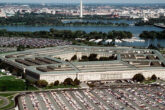August 18, 2021
From Desert Storm to Inherent Resolve: The Evolution of Airpower
On June 27, U.S. fighter jets struck weapons storage facilities used by Iranian proxy groups Kataib Hizballah and Kataib Sayyid al-Shuhada in retaliation for launching drone attacks on U.S. military facilities in the region. This was the second set of airstrikes ordered by the Biden administration in order to deter Iran and its proxies from attacking U.S. equities in the Middle East.
Just several weeks later, U.S. airpower was used once again, but this time in Afghanistan. “Over-the-horizon” airstrikes sought to bolster Afghan defenses, blunt the Taliban’s momentum, protect key urban areas, and stave off the collapse of the Afghan state.
Presidents and their advisers should be mindful that, although innovations in warfighting may achieve tactical and operational aims, they do not guarantee strategic success.
President Joe Biden’s decision to use fighter jets to strike Iranian infrastructure in Syria and Iraq, and to defend key Afghan cities, follows a familiar pattern. Since the 1991 Gulf War, U.S. presidents have chosen time and time again to use airpower to protect U.S. interests abroad. Since the six-week air campaign that immobilized and demoralized Saddam Hussein’s forces defending Kuwait, airpower has become the centerpiece of U.S. military interventions in Bosnia and Herzegovina, Kosovo, Afghanistan, Libya, and, once again, Iraq.
The U.S. airstrikes against Iranian-backed militia groups located along the Iraqi-Syrian border, and the uptick in American air support to Afghan forces, demonstrate how the model of airpower perfected against the Islamic State in Iraq and the Levant (ISIL) in Iraq and Syria has evolved. But the limited strikes on Iranian proxies and Taliban forces stand in stark contrast to the continued strikes on Islamic State leaders and targets in Iraq and Syria also authorized by the Biden administration. Previous military successes are just as likely to distort policymakers’ thinking as prior failures. The Biden administration should not harbor unrealistic expectations about what airpower can achieve, nor should it succumb to the temptation to employ airpower because it is a low-risk form of taking action.
Read the full article from War on the Rocks.
More from CNAS
-
DEFAERO Strategy Series [Apr 09, 25] CNAS' Becca Wasser and Phil Sheers on Revitalizing the U.S. Defense Industrial Base
On this episode of the Defense & Aerospace Report Strategy Series, sponsored by General Atomics Aeronautical Systems, Becca Wasser and Phil Sheers of the Center for a New Amer...
By Becca Wasser & Philip Sheers
-
From Production Lines to Front Lines
Executive Summary The U.S. defense industrial base (DIB) is struggling to meet the demands of the current strategic environment—let alone prepare for a potential conflict agai...
By Becca Wasser & Philip Sheers
-
The Pentagon’s Endangered Brain Trust
In this environment, sound assessments of emerging threats and new ideas to counter them will be especially vital....
By Dr. Andrew Krepinevich, Jr.
-
Siliconsciousness: The AI Competition: Public Policy Strategies: Part 1
This episode comprises the first part of our special event, “The AI Competition: Public Policy Strategies”. The event, co-hosted by MIT Technology Review, brings together some...
By Dr. ED McGrady




